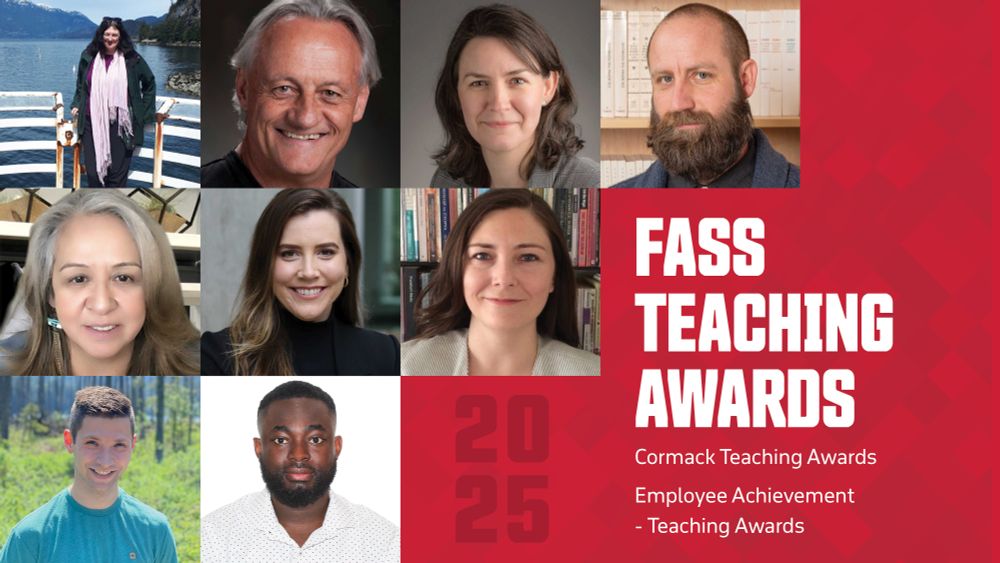SFU Faculty of Arts and Social Sciences
@sfufass.bsky.social
510 followers
200 following
92 posts
With over 28 departments/programs in the arts, humanities, and social sciences, FASS is Simon Fraser University's largest and most diverse faculty. We're committed to engaging our communities with award-winning research and teaching.
Posts
Media
Videos
Starter Packs
Pinned
Simon Fraser University
@sfu.ca
· Aug 26

New SFU–Exeter partnership fast-tracks path to become a lawyer
Simon Fraser University is breaking new ground in legal education with an exclusive international partnership that offers students a faster route to becoming a lawyer.
The new SFU-Exeter Accelerated ...
www.sfu.ca
Reposted by SFU Faculty of Arts and Social Sciences
Reposted by SFU Faculty of Arts and Social Sciences
Reposted by SFU Faculty of Arts and Social Sciences
Reposted by SFU Faculty of Arts and Social Sciences
Reposted by SFU Faculty of Arts and Social Sciences
Reposted by SFU Faculty of Arts and Social Sciences
Reposted by SFU Faculty of Arts and Social Sciences
Reposted by SFU Faculty of Arts and Social Sciences
Reposted by SFU Faculty of Arts and Social Sciences
Reposted by SFU Faculty of Arts and Social Sciences
Reposted by SFU Faculty of Arts and Social Sciences
Reposted by SFU Faculty of Arts and Social Sciences
Reposted by SFU Faculty of Arts and Social Sciences
Reposted by SFU Faculty of Arts and Social Sciences
Andy Yan
@ayan604.bsky.social
· 19d

The Vancouver Special—Blight or Brilliant? | Urban History Review
In the early 1960s, an affordable single-family dwelling emerged in Vancouver, and within two decades, over 10,000 were constructed, predominantly on the east side of the city. The plan-based design was tailored to the city’s lot sizes, floor square ratios, and climatic conditions, with its low slope roof and shallow foundation and, as a result, could be approved and constructed quickly. The flexible use of interior space allowed owners to put in a legal rental suite on the bottom floor as a mortgage helper, which made ownership more accessible to working-class families. Despite its popularity among homeowners, the Vancouver Special, as it was pejoratively called, was no longer approved for construction by 1984 because of fears that the residential landscape was becoming too homogenized. The fears of homogenization, the author argues, are based on the ways the Vancouver Special disrupted the embedded cultural and colonial domestic architectural norms, which reflected primarily British racial and class ideals of homeownership. By declaring the design a blight on the landscape, it overshadowed the ways in which the Vancouver Special helped solve housing issues in the city during the 1960s–1970s by increasing affordable housing stock, expanding the available rental market, particularly for families, and gently densifying urban neighbourhoods to help stem the exodus to the suburbs to find affordable housing. Recently, the maligned Vancouver Special has been claimed by local heritage lovers as part of the city’s unique architectural history, and there have been calls for a “new Vancouver Special” to solve the current housing unaffordability and rental crisis in the city, but the fears of homogenization of the residential landscape remain pointing to the unaddressed cultural and colonial norms attached to housing.
utppublishing.com
Reposted by SFU Faculty of Arts and Social Sciences
Reposted by SFU Faculty of Arts and Social Sciences
Reposted by SFU Faculty of Arts and Social Sciences
Reposted by SFU Faculty of Arts and Social Sciences



























